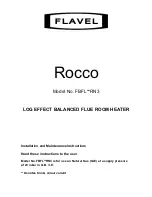
8
IO-123114 Effective 12-04-2014
9. Connecting Refrigerant Lines
1.
Release nitrogen hold
-
ing charge by depressing the
Shrader Valve at the liquid line
connection on the air handler.
If no gas releases from the air
handler, contact distributor re-
garding potential leak.
2.
Cut off Shrader Valve fitting at
the liquid line connection. Use a
tubing cutter for this step. Clean
the burr from the cut tubing to
reduce the chance of future
leaks. Connect the liquid line to
the tubing at the indoor unit.
3.
Use a tubing cutter to remove
the spun end from the suction
line connection at the air han-
dler. Clean the burr from the cut
tubing to reduce the chance of
future leaks.
4.
To avoid heat damage to grommets where present, remove these
prior to brazing by sliding them over the refrigerant lines and out of
the way.
5.
Check to determine if the
evaporator coil has a Shrader
fitting on the suction manifold.
If yes, remove the valve core
to prevent heat damage during
brazing. Replace the valve core
once the piping has cooled.
6.
If the air handler has a TXV metering device, remove the sensing
bulb from the suction line prior to brazing to prevent heat damage
from occurring. Replace the sensing bulb once the piping has cooled.
7. Flow nitrogen through the piping when brazing.
8. Braze both refrigerant line connections using proper brazing pro-
cedures.
9. When all line connections are brazed, perform a proper system
evacuation procedure per the outdoor unit manufacturer instructions.
10.
Seal the penetration openings where the lineset piping enters the
air handler cabinet.
1.
Following outdoor unit manufacturer instructions and recommen-
dations, charge the system with dry nitrogen to a maximum pressure
of 150 PSIG.
3.
If any leaks are discovered, relieve system pressure and repair
leaks. Repeat steps 1-3.
4.
With no leaks or weak connections present, evacuate the system
and charge as per the outdoor unit manufacturer instructions and
specifications.
10. Leak Check
2.
Check all brazed and screw-
on line connections by applying a
soap solution to the joint. A leak
will produce bubbles in the soap
solution.
11. Electrical Installation
These units are designed for a single phase 208/240 volts, 60 Hz
power supply. Wire selection and wiring must be in accordance with
the National Electric Code and/or local codes. Unit terminals are
designed to accommodate copper or aluminum wiring. If aluminum
wiring is used; please observe special precautions relative to sizing,
wire connections and corrosion protection.
Fig.11-1 shows the typical electrical connections required for A/C
only and heat pump applications.
All models with 3, 5, 8 or 10 kW electric heat are arranged for single
circuit connections. Fig. 11A-2 shows the typical electrical connec-
tions required for A/C only and heat pump applications.
Fig 11-1.
































